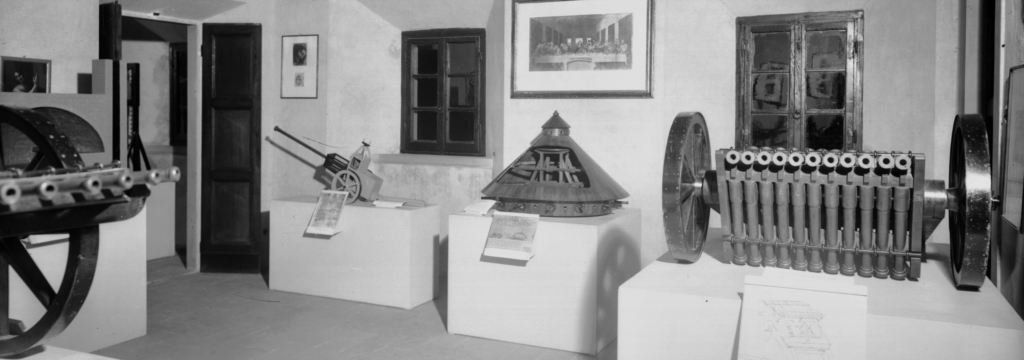
Birth and history of a collection
The idea of dedicating a museum to Leonardo in his homeland was born in 1919 during the celebrations of the 400th anniversary of his death, when the Conti Guidi’s castle was donated to the Municipality of Vinci.
After the restoration of the building between 1939 and 1942, the Leonardo Museum began its life on April 15, 1953, thanks to the generous gift from the International Business Machines Corporation (IBM), which donated to the Municipality a complete series of models reconstructed based on Leonardo’s drawings.
Main events
Foundation
On April 15, 1953, the Museo Vinciano, or the Museum of Leonardo’s Machines, was born.
At that time, the museum occupied only four rooms of the Castle, sharing space with the Leonardiana library, which moved to its current premises in 1983. Since then, the collection of machines and mechanisms has been continuously expanded thanks to contributions from scholars, donors, and investments by the Municipality, becoming one of the largest and most original collections for the critical study of Leonardo within the context of late medieval and Renaissance history and technology.
Museum Expansion
Following the relocation of the Biblioteca Leonardiana to a more suitable venue in 1983, in 1986 it became possible to dedicate the entire Conti Guidi fortress as a museum site. This allowed the exhibition layout to be renewed and the collection to be further expanded, again thanks to IBM (as well as the support of the San Miniato Savings Bank Foundation), which donated to the Museo Vinciano the machines from the traveling exhibition Laboratorio di Leonardo, curated by Augusto Marinoni and inaugurated in Milan in 1983. It was at this time that the museum took on the name “Leonardiano.”
The Sculpture of the Vitruvian Man
The large wooden sculpture by Mario Ceroli, which interprets and visualizes Leonardo’s Vitruvian Man, was inaugurated in the panoramic square behind the Conti Guidi fortress.
The extension
In the summer of 2004, the exhibition spaces were expanded by combining the Conti Guidi Castle and the Uzielli Building into a single new museum route spanning two nearby locations in Vinci’s historic center. The visit itinerary was enlarged thanks to new sections dedicated to optics, construction machinery, and textile manufacturing machines.
Piazza Mimmo Paladino
The Guidi Square is completely redesigned as the dramatic entrance to the Palazzina Uzielli, one of the Leonardo Museum’s sites, through the work of Mimmo Paladino, who won the design competition organized by the Municipality of Vinci, which then led to the exhibition A Square for Leonardo.
Restoration works at the Castle
A new significant series of interventions has been carried out in the ancient structure of the “Rocca dei Conti Guidi”, resulting in the removal of architectural barriers and a further reorganization of the exhibition layout. The collection and exhibition spaces have been renewed and expanded thanks to the close collaboration of historians, engineers, and digital modeling technicians.
Leonardo and the Anatomy
New exhibition section Leonardo and Anatomy in the Uzielli building, featuring anatomical wax models based on Leonardo’s drawings, designed by Paola Salvi and created by the Brera Academy of Milan.
Leonardo in Vinci. At the Origins of the Genius
On the occasion of the 500th anniversary of Leonardo da Vinci’s death, the Museum organized the exhibition Leonardo in Vinci. At the Origins of the Genius, which featured the famous Drawing of Landscape 8P from the Uffizi Gallery and other archival documents related to Leonardo’s birth and childhood.
The permanent exhibition retained the content of the first-floor rooms in the Conti Guidi Castle, dedicated to the inspirations that the native land offered to the great artist, such as the project for the diversion of the Arno River.
The collaboration with the "Scuola Superiore Sant'Anna" in Pisa
In 2021, thanks to a reorganization carried out in collaboration with the Scuola Superiore Sant’Anna di Pisa, which combines the study of Leonardo’s mechanics with the use of digital technology, the visit path at the Palazzina Uzielli was enriched with new exhibition spaces where multimedia installations integrate with valuable models from the museum’s historical collection.
The new sections “Leonardo’s Mechanics,” “Anatomy of Machines,” and “Clocks” were born: videos, sounds, and digital animations, as well as virtual reality accessible through headsets, create immersive ways to explore Leonardo’s technical and scientific work.
